Biography
I am currently a fellow of the Nevada Center for Astrophysics (NCfA) based at UNLV. I primarily collaborate with Bing Zhang and Zhaohuan Zhu. Prior to my role at UNLV, I pursued my PhD at Stony Brook University. I am a dynamicist interested in a diverse range of topics, including exoplanets, black hole mergers, tidal disruption events, and gamma-ray bursts. In addition to my research pursuits, I am also a dedicated developer of astrophysics software.
my CV.
- Black hole merger dynamics
- Hot Jupiter formation dynamics
- Tidal disruption events
- GRB simulations
- N-body code algorithm
-
PhD in Astronomy, 2022
Stony Brook University
-
BS in Physics, 2015
University of Science & Technology of China
SpaceHub
Recognized as one of the best codes available for black hole dynamics, SpaceHub utilizes unique algorithms for fast, precise, and accurate computations for few-body problems, ranging from interacting black holes to planetary dynamics. This few-body gravity integration toolkit can treat black hole dynamics with extreme mass ratios, extreme eccentricities, and very close encounters. SpaceHub offers a variety of integrators with round-off error controls and can handle extremely eccentric orbits and close approaches in long-term integrations.
Fork SpaceHub Github Repository
About me
Drawing
Aside from my scientific endeavors, I have a deep appreciation for the art and architecture of my hometown, Chongqing, known for its ancient Chinese-style buildings nestled in the mountainous terrain of southwest China. This passion, particularly evident in my sketches of iconic locales like ‘HongYa Dong’, stems from a childhood surrounded by the city’s rich cultural background.

Skiing
During my second year of Ph.D. studies, I tried skiing for the first time. Despite a bumpy start that led to a quick meeting with the first-aid patrol, I found myself hooked. It was a surprising but welcomed discovery, offering a hobby that was just challenging and rewarding.
As time went on, skiing became more than just a pastime. It turned into a regular activity where I could see and feel myself getting better, one ski trip at a time. The sense of progress and the fun of speeding down the slopes kept pulling me back.
Even though I started skiing in the US, I became quite interested in the approach of the Canadian Ski Instructors’ Alliance (CSIA) in Canada. Their focus on constant growth and skill development really clicked with me, mirroring my own experiences and enjoyment in the sport.
Now, I’m working slowly towards meeting the Level III certification standard from CSIA, a goal that highlights the commitment and enjoyment I’ve found in skiing over the years.
In the following video, I’ve captured one of my ski seasons with my mates before the pandemic struck. It was a time of camaraderie, laughter, and the simple joy of cruising down the slopes with friends. You can spot me easily – I’m the guy sporting the unmistakably yellow pants.
Research Posts
Jupiter Mass Binary Object (JuMBO) formation from stellar flybys
This work has been motivated by the very recent report of observations by the James Webb Space Telescope (JWST) of candidate Jupiter-Mass Binary Objects (a.k.a JuMBO), whose existence does not readily fits in any current planetary formation theory. More specifically, via dedicated N-body simulations, we set to investigate the possibility that a close flyby can result in the ejection of two planets in outer orbits, which remain bound to one another. The mass ratio between the star and planet in the scattering experiments is set to be 1e-3.

1. JuMBO formation from face-on scattering.
2. JuMBO formation from edge-on scattering.
3. Outer Jupiter ejection.
4. Inner Jupiter ejection.
5. Double ejections.
6. Outer Jupiter capture.
7. Inner Jupiter capture.
8. Double captures.
Featured Publications
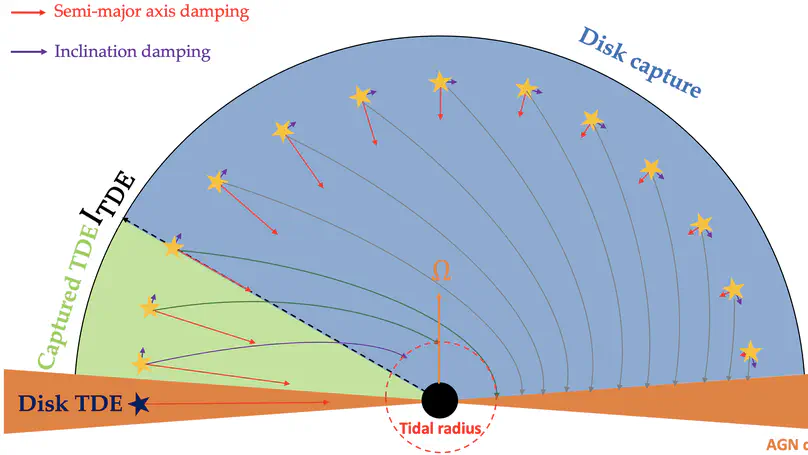
Recent observations of changing-look active galactic nuclei (AGN) hint at a frequency of accretion activity not fully explained by tidal disruption events (TDEs) stemming from relaxation processes in nucleus star clusters (NSCs), traditionally estimated to occur at rates of $10^{−4}$ to $10^{−5}$ yr$^{−1}$ per galaxy. In this letter, we propose an enhanced TDE rate through the AGN disk capture process, presenting a viable explanation for the frequent transitions observed in changing-look AGN. Specifically, we investigate the interaction between the accretion disk and retrograde stars within NSCs, resulting in the rapid occurrence of TDEs within a condensed time frame. Through detailed calculations, we derive the time-dependent TDE rates for both relaxation-induced TDE and disk-captured TDE. Our analysis reveals that TDEs triggered by the disk capture process can notably amplify the TDE rate by several orders of magnitude during the AGN phase. This mechanism offers a potential explanation for the enhanced high-energy variability characteristic of changing-look AGNs.
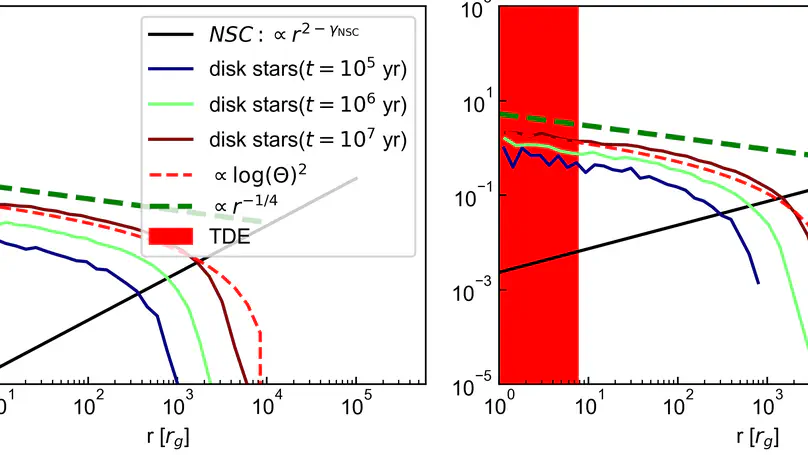
The Active Galatic Nuclei(AGN) disk has been proposed as a potential channel for the merger of binary black holes. The population of massive stars and black holes in AGN disks captured from the nuclei cluster plays a crucial role in determining the efficiency of binary formation and final merger rate within the AGN disks. In this paper, we investigate the capture process using analytical and numerical approaches. We discover a new constant integral of motion for one object capture process. Applying this result to the whole population of the nuclei cluster captured by the AGN disk, we find that the population of captured objects depends on the angular density and eccentricity distribution of the nuclei clusters and is effectively independent of the radial density profile of the nuclei cluster and disk models. An isotropic nuclei cluster with thermal eccentricity distribution predicts a captured profile $dN/dr\propto r^{−1/4}$. The captured objects are found to be dynamically crowded within the disk. Direct binary formation right after the capture would be promising, especially for stars. The conventional migration traps that help pile up single objects in AGN disks for black hole mergers might not be required.
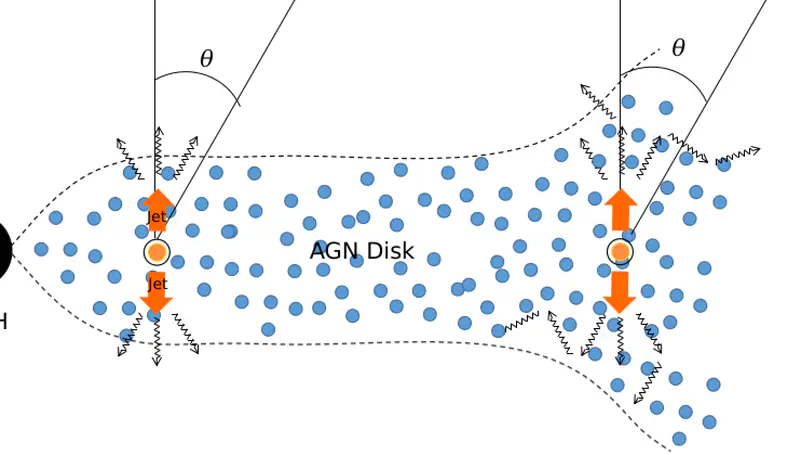
The discs of active galactic nuclei (AGNs) have emerged as rich environments for the production and capture of stars and the compact objects that they leave behind. These stars produce long gamma-ray bursts (GRBs) at their deaths, while frequent interactions among compact objects form binary neutron stars and neutron star-black hole binaries, leading to short GRBs upon their merger. Predicting the properties of these transients as they emerge from the dense environments of AGN discs is key to their proper identification and to better constrain the star and compact object population in AGN discs. Some of these transients would appear unusual because they take place in much higher densities than the interstellar medium. Others, which are the subject of this paper, would additionally be modified by radiation diffusion, since they are generated within optically thick regions of the accretion discs. Here, we compute the GRB afterglow light curves for diffused GRB sources for a representative variety of central black hole masses and disc locations. We find that the radiation from radio to ultraviolet and soft X-rays can be strongly suppressed by synchrotron self-absorption in the dense medium of the AGN disc. In addition, photon diffusion can significantly delay the emergence of the emission peak, turning a beamed, fast transient into a slow, isotropic, and dimmer one. These would appear as broad-band correlated AGN variability with a dominance at the higher frequencies. Their properties can constrain both the stellar populations within AGN discs and the disc structure.
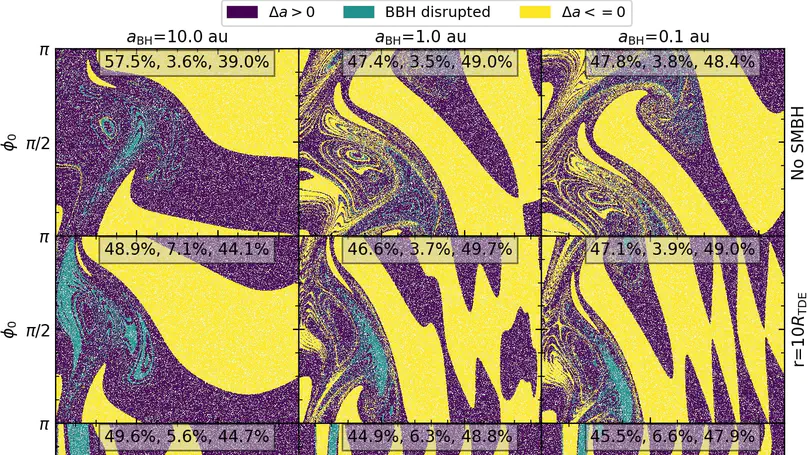
The disks of active galactic nuclei (AGNs) may be important sites of binary black hole (BBH) mergers. Here we show via numerical experiments with the high-accuracy, high-precision code SpaceHub that broken symmetry in dynamical encounters in AGN disks can lead to asymmetry between prograde and retrograde BBH mergers. The direction of the hardening asymmetry depends on the initial binary semi-major axis. Under the assumption that the spin of the BHs becomes aligned with the angular momentum of the disk on a short timescale compared with the encounter timescale, an asymmetric distribution of mass-weighted projected spin $\chi_{\rm eff}$ is predicted in LIGO-Virgo detections of BBH mergers from AGN disks. In particular, this model predicts that positive $\chi_{\rm eff}$ BBH mergers are most likely for encounters with massive tertiaries in migration traps at radial distances ≳500-600 gravitational radii.
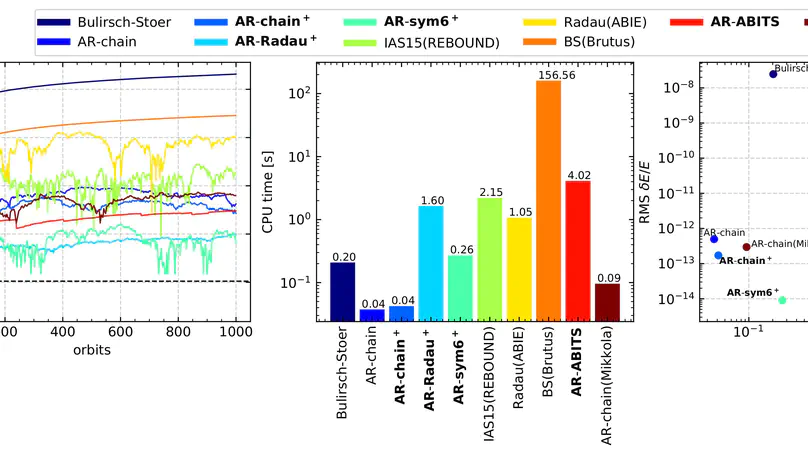
We present the open source few-body gravity integration toolkit {\tt SpaceHub}. {\tt SpaceHub} offers a variety of algorithmic methods, including the unique algorithms AR-Radau, AR-Sym6, AR-ABITS and AR-chain+ which we show out-perform other methods in the literature and allow for fast, precise and accurate computations to deal with few-body problems ranging from interacting black holes to planetary dynamics. We show that AR-Sym6 and AR-chain+, with algorithmic regularization, chain algorithm, active round-off error compensation and a symplectic kernel implementation, are the fastest and most accurate algorithms to treat black hole dynamics with extreme mass ratios, extreme eccentricities and very close encounters. AR-Radau, the first regularized Radau integrator with round off error control down to 64 bits floating point machine precision, has the ability to handle extremely eccentric orbits and close approaches in long-term integrations. AR-ABITS, a bit efficient arbitrary precision method, achieves any precision with the least CPU cost compared to other open source arbitrary precision few-body codes. With the implementation of deep numerical and code optimization, these new algorithms in {\tt SpaceHub} prove superior to other popular high precision few-body codes in terms of performance, accuracy and speed.
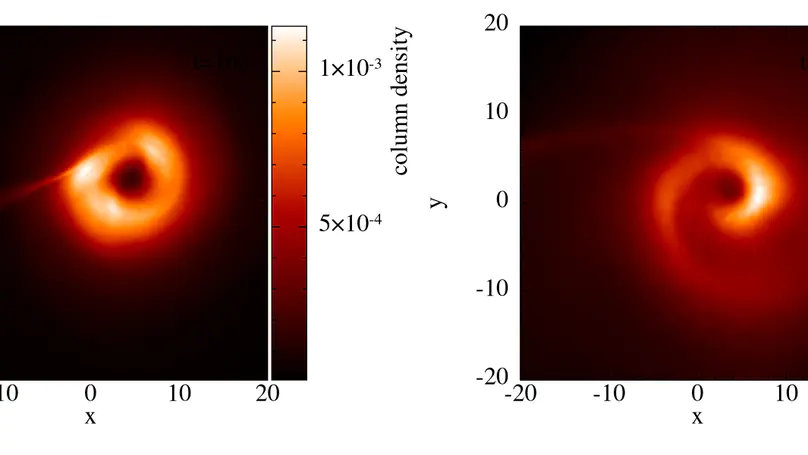
In dense star clusters, such as globular and open clusters, dynamical interactions between stars and black holes (BHs) can be extremely frequent, leading to various astrophysical transients. Close encounters between a star and a stellar mass BH make it possible for the star to be tidally disrupted by the BH. Due to the relative low mass of the BH and the small cross section of the tidal disruption event (TDE) for cases with high penetration, disruptions caused by close encounters are usually partial disruptions. The existence of the remnant stellar core and its non-negligible mass compared to the stellar mass BH alters the accretion process significantly. We study this problem with SPH simulations using the code {\tt Phantom}, with the inclusion of radiation pressure, which is important for small mass BHs. Additionally, we develop a new, more general method of computing the fallback rate which does not rely on any approximation. Our study shows that the powerlaw slope of the fallback rate has a strong dependence on the mass of the BH in the stellar mass BH regime. Furthermore, in this regime, self-gravity of the fallback stream and local instabilities become more significant, and cause the disrupted material to collapse into small clumps before returning to the BH. This results in an abrupt increase of the fallback rate, which can significantly deviate from a powerlaw. Our results will help in the identification of TDEs by stellar mass BHs in dense clusters.
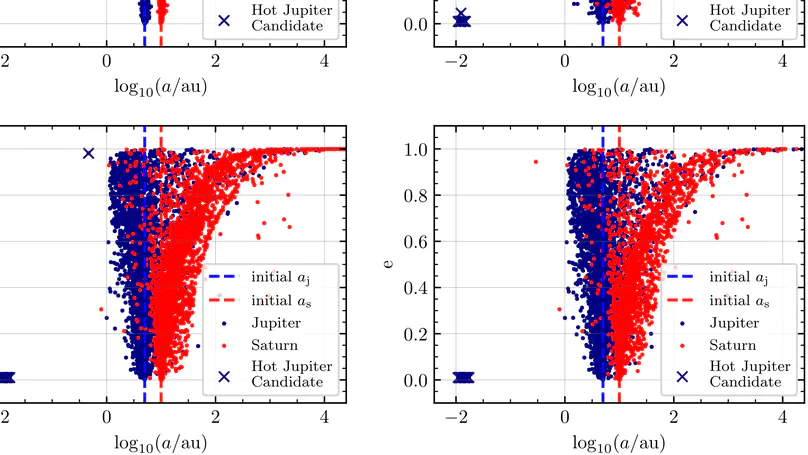
The discovery of high incidence of hot Jupiters in dense clusters challenges the field-based hot Jupiter formation theory. In dense clusters, interactions between planetary systems and flyby stars are relatively common. This has a significant impact on planetary systems, dominating hot Jupiter formation. In this paper, we perform high precision, few-body simulations of stellar flybys and subsequent planet migration in clusters. A large parameter space exploration demonstrates that close flybys that change the architecture of the planetary system can activate high eccentricity migration mechanisms: Lidov-Kozai and planet-planet scattering, leading to high hot Jupiter formation rate in dense clusters. Our simulations predict that many of the hot Jupiters are accompanied by “ultra-cold Saturns”, expelled to apastra of thousands of AU. This increase is particularly remarkable for planetary systems originally hosting two giant planets with semi-major axis ratios $\sim$ 4 and the flyby star approaching nearly perpendicular to the planetary orbital plane. The estimated lower limit to the hot Jupiter formation rate of a virialized cluster is $\sim 1.6\times10^{-4}({\sigma}/{\rm 1kms^{-1}})^5({a_{\rm p}}/{\rm 20 AU})({M_{\rm c}}/{\rm 1000M_\odot})^{-2}$~Gyr$^{-1}$ per star, where $\sigma$ is the cluster velocity dispersion, $a_{\rm p}$ is the size of the planetary system and $M_{\rm c}$ is the mass of the cluster. Our simulations yield a hot Jupiter abundance which is $\sim$ 50 times smaller than that observed in the old open cluster M67. We expect that interactions involving binary stars, as well as a third or more giant planets, will close the discrepancy.
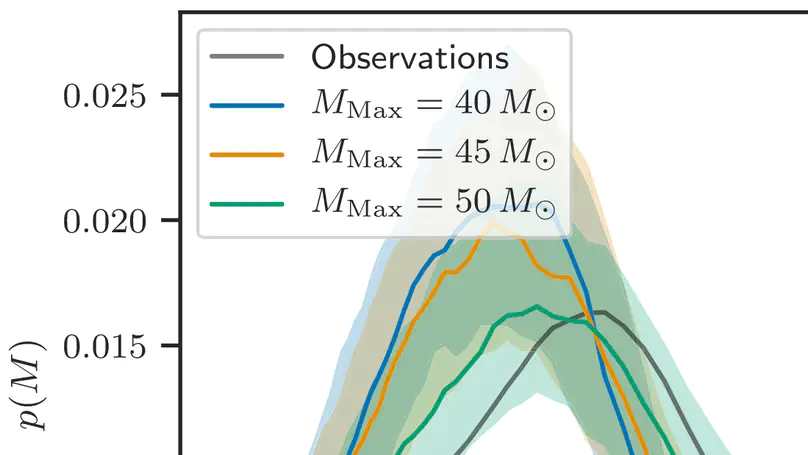
Prior to the detection of black holes (BHs) via the gravitational waves (GWs) that they generate at merger, the presence of BHs was inferred in X-ray binaries, mostly via dynamical measurements, with masses in the range between $\sim $5 and 20 $M_\odot$. The Laser Interferometer Gravitational-Wave Observatory (LIGO) discovery of the first BHs via GWs was surprising in that the two BHs that merged had masses of $35.6_{-3.0}^{+4.8}$ and $30.6_{-4.4}^{+3.0}$ $M_{\odot}$, which are both above the range inferred from X-ray binaries. With 20 BH detections from the first/second observing (O1/O2) runs, the distribution of masses remains generally higher than the X-ray inferred one, while the effective spins are generally lower. This suggests that, at least in part, the GW-detected population might be of dynamical origin rather than produced by the common evolution of field binaries. Here we perform high-resolution N-body simulations of a cluster of isolated BHs with a range of initial mass spectra and upper mass cutoffs, and study the resulting binary mass spectrum resulting from the dynamical interactions. Our clusters have properties that are similar to those of the massive remnants in an OB association $\sim$10 Myr after formation. We perform a likelihood analysis for each of our dynamically formed binary population against the data from the O1 and O2 LIGO/Virgo runs. We find that an initial mass spectrum $M_{\rm BH}$ $\propto M^{−2.35}$ with an upper mass cutoff $M_{\rm max}$ $\sim$ 50 $M_\odot$ is favored by the data, together with a slight preference for a merger rate that increases with redshift.